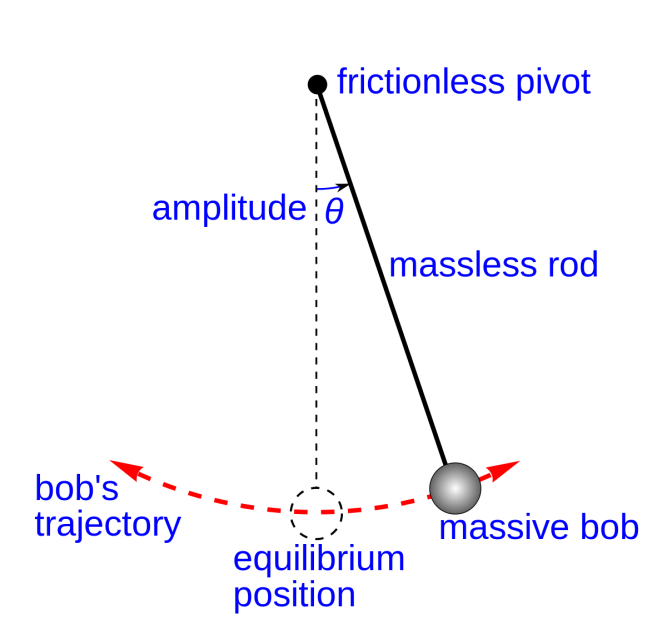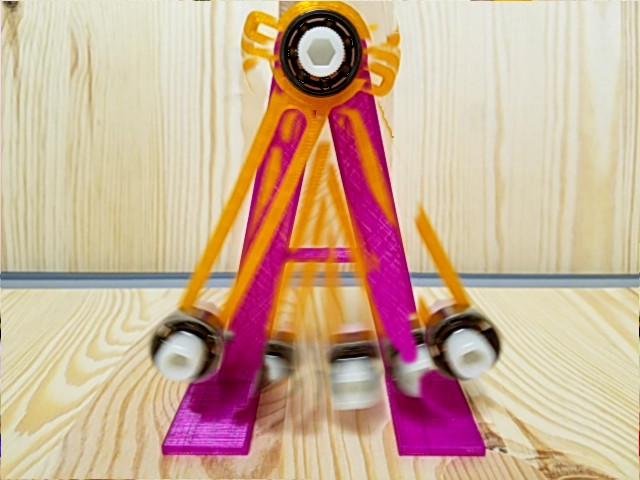3D Printed Pendulum for Simple Harmonic Motion
This 3D printed model demonstrates the physics of a simple pendulum that consists of a mass, m, hanging from an arm of length, L, and fixed at a pivot point, P. You can move the mass along the length of the arm to change the center of mass of the pendulum. If you displace the pendulum from equilibrium to an initial angle, θ, and release, the motion will be regular and repeat. This is an example of periodic motion also called simple harmonic motion.

Materials
You can find the 3D printer files (.stl files) here and on the PocketLab Thingiverse page. The pendulum consists of the base and the pendulum arm. There are internal threads in the base part, so select an appropriate printer resolution so that the threads will be functional.
The hardware parts we use are below. We order the bolts and spacers from McMaster-Carr and the ball bearings on Amazon. You can also use washers and normal steel bolts from your local hardware store.
- 2x bolt, 5/16-18, 3/4" long, link
- 1x spacer, 5/16 ID, 1/4" long, link
- 1x hex nut, 5/15-18, link
- 2x ball bearings, 8mm ID, link
Assembly
- Press fit one of the ball bearings into the top of the pendulum arm
- Insert the bolt through the ball bearing and spacer and thread into the pendulum base. The side of the pendulum arm with the raised channel edge should be closest to the pendulum base
- Insert a bolt though another ball bearing and into the long channel in the pendulum arm. Tighten the nut on the other side of the arm
- The nut should fit into the raised edge of the channel so that you can easily loosen the bolt and slide it up and down the pendulum arm.
- We used an extra ball bearing as the pendulum mass. You can also use metal washers or other hardware.

Objectives
In this experiment, students can
- Use the scientific method to discover what variables affect the period of the pendulum.
- Explain why certain variables affect the period of the pendulum and certain variables do not.
A shorter pendulum length results in a shorter period of oscillation than a longer pendulum length. You can slide the mass up and down the pendulum arm to vary the center of mass of the pendulum which changes the effective length of the pendulum.

Experimental Procedure (without a PocketLab)
Vary Position of Mass (Changes Effective Length of Pendulum)
- Move the mass to the bottom of the pendulum and tighten the screw
- Move the pendulum arm to a specific angle (measured with the protractor) and release.
- Using a timer or stopwatch, start the timer when you release the pendulum
- Let the pendulum oscillate back and forth 10 times
- Stop the timer and record the amount of time elapsed
- Divide the total time recorded by 10 to calculate the time of a single oscillation
- Adjust the position of the mass up the pendulum arm in regular intervals
- Repeat the measurement of the pendulum period in Steps 3-6
Vary Initial Pendulum Angle
- Move the mass to the bottom of the pendulum and tighten the screw
- Move the pendulum arm to a specific angle (measured with the protractor) and release
- Record 10 oscillation periods and calculate single period length as before
- Increase the starting angle by 5 degree increments and repeat tests.
Vary Pendulum Mass
- Move the mass to the bottom of the pendulum
- Add more mass to the pendulum using metal washers or other small dense objects to the end of the pendulum
- Repeat experimental procedure as before.
Data Analysis Questions
- For the different pendulum lengths, examine the data from all the trials and the averages of each trial. How did the length of the pendulum affect the period of the pendulum? Use data to support your answer.
- For the different initial angles, examine the data from all the trials and the averages of each trial. How did the initial angle affect the period of the pendulum? Use data to support your answer.
- For the different masses, examine the data from all the trials and the averages of each trial. How did the length of the string affect the period of the pendulum? Use data to support your answer.
Data Analysis Explained
For a simple model of a pendulum good experimental results will show that the only variable that affects the period of pendulum is the pendulum length. Different initial angles and different pendulum masses will not change the period length. The classic result is that the pendulum period, T is

where g is the acceleration due to gravity (9.8 m/s^2).
However, this is only true if several simplifying assumptions are true: all the mass of the pendulum is in the pendulum bob, small initial angles of oscillation are used, there is no air resistance, etc.
Using this 3D printed kit, you will probably get results that deviate from the ideal model, which can be a good thing! That means you have to conduct the experiment without already knowing the right answer.


